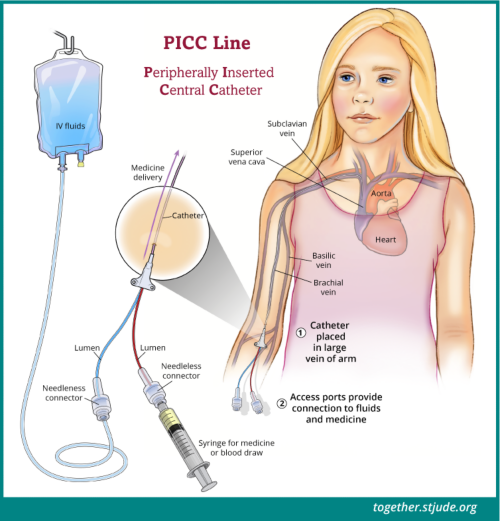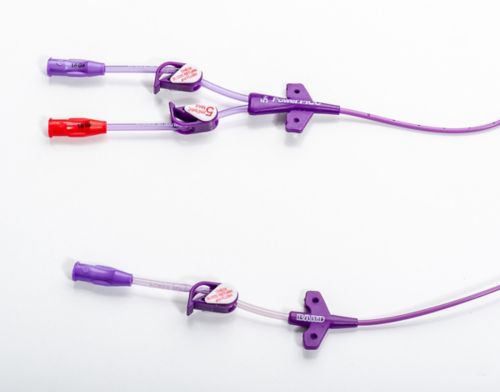A PICC line is a type of central venous catheter (central line). PICC stands for peripherally inserted central catheter. A PICC line is a long, thin tube inserted into a vein on the inside of the upper arm and extends into a larger vein leading to the heart.
A PICC line allows medicines, nutrition, blood products, and fluids to be given into a large vein. Blood samples can also be taken.
One end of the catheter stays outside the skin and has one or two tubes called lumens. Each lumen has a cap called a needleless connector placed on the end. The connectors keep the lumens from leaking and keep air and bacteria out. The connectors allow medicines and fluids to be given without needle sticks.
A dressing is worn over the area to protect against infection and keep the catheter in place. The catheter can stay in place for months before it needs to be removed and replaced if needed.
It is important to take good care of the PICC line and follow all instructions to prevent infection and keep the line working properly.
Advantages of a PICC line
- A PICC line reduces the need for needle sticks for medication, fluids, nutrition, blood products, and blood samples.
- A PICC line can be placed with a patient receiving only mild sedation or none at all.
- The device is easy to access.
- A PICC line can stay in place for a long time.
- Some medicines can irritate blood vessels. A PICC line is placed in a large vein with high blood flow so there is less irritation.
- With some types of PICC lines, more than one type of medication or solution can be given at the same time.
- A PICC line can often be used to give medication at home, making it easier for patients and families to continue therapy.
- A PICC line can be removed in the clinic.
Risks of a PICC line
There are always risks involved with anesthesia and surgery. The main risks during insertion include puncture of a blood vessel, blood clots, irregular heartbeat, nerve injury, and infection. After line placement, blood clots, movement of the catheter out of position, vein inflammation, and infection are the most common complications.
Serious complications are rare, but they do occur. Be sure to ask questions and follow all instructions given by the care team.
Many patients are awake during the procedure to insert a PICC line. Younger children may be given medicine to help them sleep or relax during the procedure. Patients who receive general anesthesia will be given NPO instructions for limiting food and drink before the procedure. It is very important to follow these guidelines. The actual placement of a PICC line usually takes about 15-30 minutes. The total time for the procedure can be 1-2 hours with anesthesia and recovery.
- Before PICC line placement, patients will have blood work and a physical exam. Members of the care team will meet with the family to complete paperwork and answer questions.
- The procedure may be done in a treatment room or in the child’s hospital room. A parent may be able to stay in the room, depending on medical center policies.
- Some children will receive anesthesia so that they are asleep during the procedure. Children who are awake may be able to listen to music or watch videos during the procedure.
- The patient will lie down on the treatment table. Ultrasound imaging will be used to locate the vein. During the ultrasound, a rubber band is tied around the arm so that the vein is easier to see. This will feel tight but should not hurt, and it will be removed after the imaging. A cold gel is used so that the machine can get a clear picture.
- The care team will wear gowns, masks, and gloves. Usually, the patient will need to change into a gown. A blue paper drape will also be used to cover the patient’s body except for the area of the arm. This helps keep the area clean and prevent infection.
- The skin in the area will be cleaned. Then, the area will be numbed using a local anesthetic to reduce pain. This is usually an injection. The medicine may sting for a few seconds.
- Once the area is numbed, a needle will be inserted into the vein in the arm. Using ultrasound or fluoroscopy guidance, a guide wire will be carefully moved up through the vein toward the heart. The guide wire is used to measure the required length of the PICC. The PICC line is then cut to the appropriate length and inserted over the guide wire until the tip of the catheter stops in the superior vena cava near the heart.
- When the catheter is in the correct position, the guide will be removed. The catheter will stay in place inside the vein. One end of the catheter will be near the heart; the other end will be outside the skin.
- After the PICC line is placed, it will be covered to keep it secure and clean. The skin will be cleaned, and a disc will be placed over the site where the catheter exits the skin. An end cap will be placed on the end of the catheter tubing where medication is given. A clear plastic dressing will hold the catheter in place on the arm.
- Fluoroscopy or X-ray will be used to check the position of the catheter.
- A nurse will draw a small amount of blood to make sure the catheter is working properly.
- Patients who receive general anesthesia will spend a short time in recovery, usually about an hour. If the patient is going home, a nurse will go over care instructions.
Your care team will teach you how to care for the PICC line. PICC lines must be flushed daily with heparin. Heparin is a medicine that keeps blood from clotting and blocking the line. A dressing is worn over the area to prevent infection and keep the catheter in place. The dressing is changed once a week. The dressing must be changed if it gets wet, dirty, or comes off. It is important to keep the dressing from getting wet during bathing.
What to expect after getting a PICC line
First days
It may take a few days to get used to the PICC line. Your child's arm may feel sore or stiff. There may be some bruising.
It may feel like the line is pulling on the outside of the skin.
Getting medicine
Medications may be given with a syringe or an IV bag. Let your care team know if your child has any pain or discomfort while getting medications.
General care
Follow all care instructions to keep the line working properly and to prevent infection. Always wash your hands before touching the catheter. The needleless connector should be cleaned before each connection to the line.
Your child should avoid activities that could damage the catheter, such as contact sports or rough play. Your child should not swim with a PICC line because it increases the risk of infection.
Make sure the line is secured, and keep a clean, dry dressing over the site at all times. Watch for cracks or other signs of damage to the line.
A Central Line Associated Blood Stream Infection (CLABSI) can be life-threatening. Call your doctor at any sign of infection such as pain, redness, swelling, or fever.





